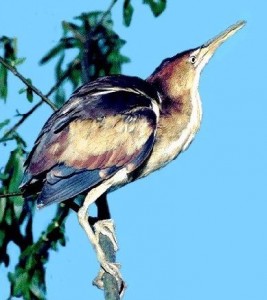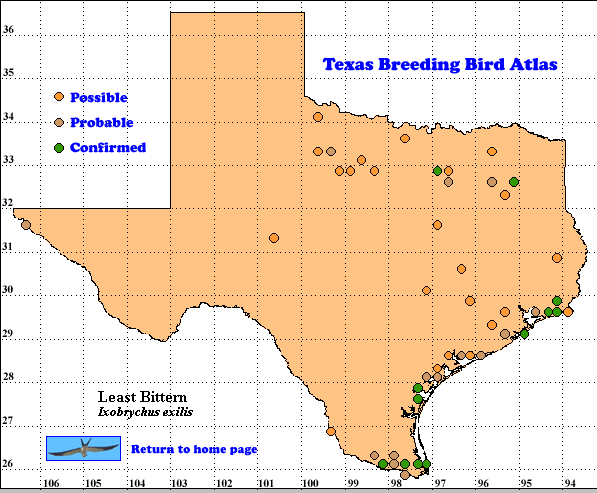Least Bitterns are cryptically colored and secretive; they can also,exist in small patches of marsh habitat that are often overlooked. Thus, they have probably escaped detection in many locations in Texas.
In Texas, an important influence on waterbird populations is the 20-25 year precipitation cycle (Telfair 2002). Between the early 1960s and the late 1980s, there was a significant upward trend in the cycle; since then, the trend has begun to decrease (Tom Spencer, Texas Forest Service, pers. comm.). The trend varies regionally and there are intermittent drought years and irregular intervals with pronounced wet/dry springs-summers such as those associated with El Niño/La Niña years and massive slow-moving atmospheric disturb- ances (Dr. Robert K. Peters, NWS Observer for Tyler, Texas, pers. comm.). Inland wetland habitats are particularly subject to the effects of these trends. Unfortunately, there is a lack of data about the status of the Least Bittern in Texas. However, if marshy wetlands of <10 ha (> 25 acres) remain undisturbed and unpolluted, Least Bitterns are tolerant of human presence and may persist in highly urbanized areas (Gibbs et al. 1992).
Least Bitterns are not censused during Texas colonial waterbird nesting surveys. However, since 1980, they have been included in North American Breeding Bird Surveys (BBS).
DISTRIBUTION: Least Bitterns are rare to locally common summer residents throughout the eastern half of Texas, west to the Balcones Escarpment and south to the Lower Rio Grande Valley wherever marsh habitats occur. However, most breeding records are from the upper coast and southern Rio Grande Valley (Oberholser 1974, TBBA). In the western half of the state, they are very rare, local summer residents with scattered isolated breeding records from El Paso, Hemphill, Midland, Presidio, Reeves, Tom Green, and Val Verde counties (Lockwood and Freeman 2004). Since 1991, there has been a new county breeding site record in northeast Texas — an inland salt marsh at Grande Saline, Van Zandt County where one nest was found (Lasley et al. 1991).
SEASONAL OCCURRENCE: Least Bitterns breed from late March to mid-August; with eggs found from April 13 to July 20; and nestlings from June 9 to August 13 (Oberholser 1974). Least Bitterns are rare touncommon migrants throughout the state and are very rare winter residents in the Coastal Prairies (Lockwood and Freeman 2004).
BREEDING HABITAT: In east Texas, Least Bitterns inhabit freshwater and brackish marshes with dense, tall growth of aquatic or semi-aquatic vegetation, particularly cattails (Typha spp.), sedges (Carex spp.), bulrushes (Scirpus), arrowheads (Sagittaria spp., sawgrass (Cladium jamaicense), and common reed (Phragmites australis) interspersed with clumps of woody vegetation, e.g., common buttonbush (Cephalanthus occidentalis) and open water (Gibbs et al. 1992, Kushlan and Hancock 2005). In west Texas, natural cattail and rush marshes are relatively rare and local. In the twentieth century, numerous reservoirs have been constructed there and marshes commonly have developed below the dams and where lakes and ponds are maintained at constant water levels (Maxwell 1977).
Least Bitterns nest as single pairs or in small colonies that are placed in emergent herbaceous plants or shrubs from 0.1-0.2 m (4-8 in) above the water and near open channels or openings within a marsh (Gibbs et al. 1992). Nests in colonies can be as close as 1 m (3.3 ft), resulting in densities of 3-4 nests per 100 m2 (1076 ft2; Kushlan 1973).
STATUS: Like the American Bittern (Botaurus lentiginosus), Green Heron (Butorides virescens), and Yellow-crowned Night-Heron (Nyctanassa violacea), the cryptic coloration, secretiveness, and scattered small colonies of the Least Bittern makes detection difficult and no reliable nesting census data are available. However, BBS data for Texas (Sauer et al. 2005) give an annual trend of 4.5% (1980- 2005) and 2.0% (1966-2005); thus indicating an increasing trend.

